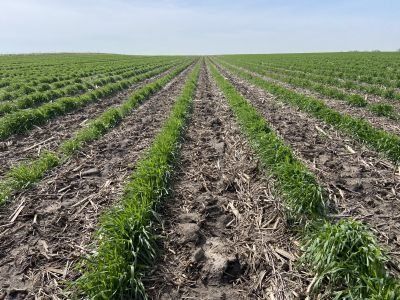Presidential Notice of Farmers as Climate Change Solution Partners

By Nancy Kavazanjian: Beaver Dam, Wisconsin
When President Biden addressed Congress and the country last week, he did something I’d never heard a president do before: In a State of the Union address, he endorsed a specific farming practice.
The “cover crops” he referenced make good agronomic sense for farmers in the United States and around the world. They also make good ecological sense for everyone concerned about the climate and our environment.
In my life as a farmer, I’ve heard many presidents give speeches. They’ve praised our patriotism and hard work. They’ve highlighted our innovations and social issues. Although these things are nice to hear, too often they feel like political pandering.
In the past when presidents mentioned agricultural policies at all, they might mention foreign policy or agricultural exports, important issues for farmers. But usually, that’s where they stop.
What presidents don’t do—at least not in my experience as a listener—is cite a farm-management technique.
Yet that’s what Biden did, as he ticked off the ways he hopes to tackle the problem of climate change: “Farmers planting cover crops so they can reduce the carbon dioxide in the air and get paid for doing it.”
I can imagine the questions of ordinary Americans who watched the speech on television: What the heck are cover crops? Do they taste good?
I’ll answer the second question first: They aren’t harvested for eating, although some of them such as radishes and turnips do taste good!
So what are they?
Their basic purpose is to cover our fields with green plants when we’re not growing our major feed, food, fuel or fiber crops. Think of them as blankets protecting our fields from the elements. They defend against soil erosion, scavenge and store nutrients, and allow the earthworms, soil bacteria and good microbes that we can’t see but know are there to thrive.
What’s more, they can help in the fight against climate change by sequestering carbon—just as President Biden said. And they do this all while protecting the environment and our precious soil!
Here in Wisconsin, my husband and I had been working to incorporate cover crops into our crop farming rotation for about 20 years. We first experimented with different clovers, on the advice of our agronomist, since we always are eager to try new, innovative ideas that can benefit our farming system. Establishing cover crops in our area isn’t the easiest thing we’ve ever done, but it certainly is one of the smartest for the health of our soil.
The general idea is to plant a small grain such as rye, or even better, a mix of grains, legumes and brassicas such as turnips and radishes after harvesting the main crop, so that fields don’t lie bare. This is especially important when you have rolling landscapes, light soils or fields adjacent to streams, lakes, or other waterways. But it can be a hard thing to do in northern climates where the growing season ends before we’ve finished harvesting our crops.
Make a virtual visit to my farm: You’ll see the rolling landscape, known as “drumlin”, carved eons ago by glaciers. With land this contoured, soil erosion can be a threat. Heavy rains and snow melt may wash away our soil, so we use cover crops and perennial plantings to help keep it in place. Combined with our no-till planting, we’re doing what we know to protect our soil and the nutrients it contains, from washing away.
Cover crops even beautify our fields. We often include sunflowers in our cover crop mix, so our fields are beautiful and visible to the public. Some of the biggest fans of our cover crops are our non-farming neighbors who stage family photos in our fields!
Cover crops aren’t free: They can be expensive, and they can be difficult to manage, which may be why some farmers hesitate to use them. Yet we believe that over time, our investment has paid off by enriching our soil, protecting our waterways and producing better crops. And new technologies and precision farming methods are helping make the process easier.
All farmers work to limit the threat of climate change, from reducing tillage to planting trees and using alternative sources of energy, such as renewable fuels, wind and solar power. Cover crops is another great strategy to sequester carbon in the soil and build a more resilient cropping system, especially if we get technical and financial assistance to offset some of the cost to adopt and establish them.
What I like most about Biden’s approach to climate change is, rather than viewing farmers as part of the problem, he sees us as part of a solution.
Nancy Kavazanjian and her husband Charles Hammer are innovative crop row farmers growing corn, soybeans and wheat in Beaver Dam, Wisconsin. Nancy is a member of the Global Farmer Network. www.globalfarmernetwork.org











































































































